Supplies needed:
» Yogourmet® Multi Yogurt machine
» Yogourmet clip-on thermometer
» Yogourmet freeze-dried yogurt starter -OR- fresh, plain yogurt without additives
» Nonfat dried milk powder (optional)
» 2½ – 3 quart stainless steel pot
» ½ gallon glass container (optional)
» Wooden stirring-spoon
» Rubber scraper
» Large plastic spoon (a ladle)
» Whisk
» Coffee filters, 8-10 cup size (we like the unbleached kind)
» 2 qt. plastic strainer with handle (Tupperware made one that’s perfect)
» Large bowl (like a salad bowl)
» Adhesive tape (Scotch© brand Magic Tape works best)
TIP: Check out the Links page to see some of the useful gadgets listed above.
Once you’re ready, here are our easy step-by-step directions:
Yogurt-Making Directions
(First-things-first)
As we’ve said, we like to use the Yogourmet® Yogurt Maker and the ½-gallon glass jar (see the Links page for how to order the jars). The plastic container that comes with the Yogourmet® Yogurt Maker can certainly be used instead of the glass jar – we simply prefer to use glass.
If you will be using fresh, plain yogurt as your yogurt starter take it out of the refrigerator and allow to sit out while preparing the milk for incubation. You will need 3 to 4 tablespoons of fresh, plain, unsweetened (sans additives) yogurt per ½ gallon of milk.
TIP: We typically use low-fat milk (1% or 2%) to keep the calories low.
OPTIONAL: If we use fresh yogurt as the “starter”, we generally like to add 1/4 to a 1/2 cup of nonfat dried milk solids to the milk batch. It really seems to increase the richness without extra fat. But, sometimes we splurge and just use milk higher in fat – which also works and then we just skip using the dried milk.
Oh and… when preparing the yogurt it’s important to keep workspaces clean so no weird germ substances harm the yogurt-cultures.
Okay, now let’s start…
1.) Fill a 2-½ to 3 quart stainless steel pot with a half-gallon container of organic milk. Heat milk on medium to medium-high heat until heat bubbles begin to appear around the edges. Stir frequently.

2.) After the milk begins to heat and heat-bubbles begin to appear, attach the thermometer onto the side of the pot and keep your eyes peeled for the temperature to begin to rise. (There’s really no need to attach the thermometer until the milk has started to heat – which also helps keep the thermometer from being damaged by the steam.)

Continue watching the temperature gauge and stirring the milk. The milk must reach 180 degrees Fahrenheit (82 Celsius). Milk should be stirred before taking a temperature reading to assure heat is fully distributed. Heating of the milk is an important step to kill any bacteria that could be present.
Once 180 degrees has been reached, remove pan from heat and allow milk to sit and maintain approx 180 degrees for about 1 to 2 minutes.
3.) During the time you are busily heating and stirring the milk, you may also do the following:
(But not to worry, if you’d rather concentrate on watching the pot of milk heat up, these steps can always be done after the milk has reached its heating point and while its cooling down.)
a) Prepare the Yogurt Maker machine by adding lukewarm tap water just to the top of the taller two lines that are marked on the bottom inside the unit. (You would use less water if you were using 2 quarts of milk.)
Set Yogurt maker in a place where it won’t be disturbed, but don’t plug it in yet.
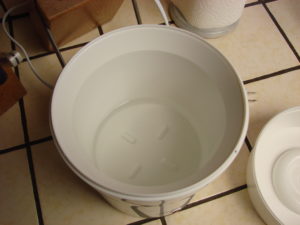
TIP: Complete instructions do come with the Yogurt Maker. We just have our own special way of preparing the yogurt that works for us – which is what this site is all about! Eventually, you will find the method that works best for you.
b) Pour a small amount of water in the glass (‘incubation’) jar and in the plastic lid, and heat them both in the microwave on high for about 1 minute. This should help to kill (or at least deter) any weird germs that might be lurking in the jar or lid that could harm the live cultures. After heating, handle the jar and lid carefully when emptying out the hot water.
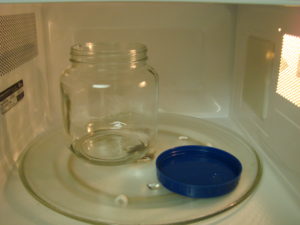
TIP: You can definitely use the plastic container that comes with your Yogourmet Yogurt maker, we just like to use a glass jar for “incubating” the yogurt.
4.) After the milk has been heated to the correct temperature and while it is cooling, prepare the sink or a large bowl with water and ice to use for the cooling process.
Place the pan of milk into the ice bath and allow to cool until temperature drops to between 108 to 112 degrees Fahrenheit (42 – 44 Celsius). This can take between 10-15 minutes if using an ice-bath.
Note: You don’t have to use an ice-bath – the cooling process just goes faster if you do.
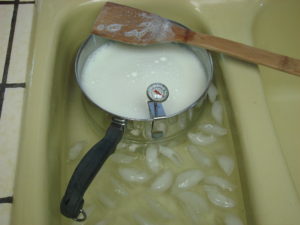
Keeping the thermometer in the pot of milk, stir at frequent intervals to help with the cooling process. Milk is ready once the temperature has reached between 108 & 112 degrees.
IMPORTANT: This cooling step must not be skipped or the high heat of the milk will kill the friendly cultures in the yogurt!
5.) After milk has cooled to the correct temperature remove the pot from the ice bath and add 10 grams (two, 5-gram packets) of Yogourmet Freeze-dried yogurt starter per half gallon of milk OR 3 to 4 tablespoons of fresh plain yogurt (containing live cultures and should not have any additives or sweetners).
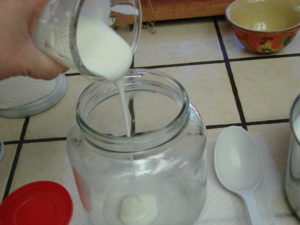
OR:
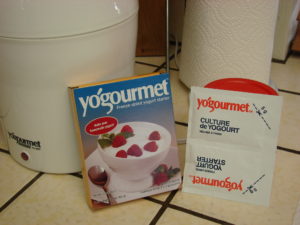
NOTE: If using your own fresh yogurt as starter, don’t use more than 3 to 4 tablespoons as more is not better in this case. We generally use our own freshly made yogurt as a starter for a few months. It seems to get better and better despite what some people say about using it only three or four times. Since we make yogurt at least once a week, it never has a chance to get old.
6.) Using a large plastic spoon, pour or ladle out about 6 to 8 spoonfuls of the cooled-down milk into the glass jar that contains your yogurt starter. Stir well to completely dissolve the fresh yogurt (or freeze-dried granules).
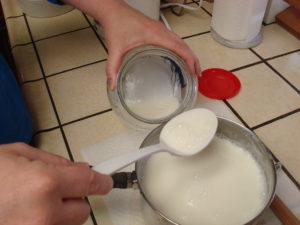
7.) Pour the remaining amount of cooled-down milk into the glass jar up to the bottom of the lid-screw lines; once again, stir stir stir.

(If there’s milk left over have some warm milk and cookies!)
8.) With a clean paper towel, wipe any milk off the rim of the jar, screw the lid on tightly and place the jar into the water-filled Yogourmet Yogurt maker machine.
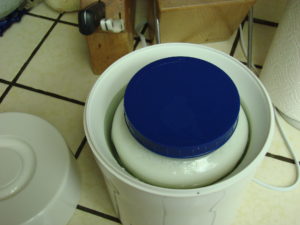
9.) Allow the yogurt to incubate undisturbed from 6 to 10 hours. No peeking or disturbing the maker. The yogurt can be incubated up to 24 hours (34 hours maximum – see the instruction manual that comes with the Yogourmet Yogurt maker for optimum times.

TIP:: We personally like to incubate our yogurt for at least 12 hours and preferably more. Usually we make it at night before bed then when we wake up in the morning, the yogurt has hatched!
So… just how do I know when the yogurt is finished incubating?
When you open the lid to the yogurt maker, you should see through the top of the jar that the yogurt is “set”. It will be somewhat gelatinous, even though you have added no gelatin into it.
Remove the jar from the yogurt maker and unscrew the lid. Most likely there will be a watery, slightly yellow liquid on top called “whey”. At this point, you can whisk the yogurt, chill it, and eat it as is.
It is your choice to pour off the whey or stir it back in…
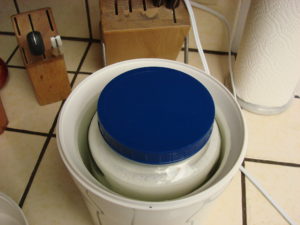
Voilà!
OR… would you rather your yogurt be THICKER (like “Greek-Style”)?
(Our choice is to begin the straining of the yogurt to make it
thicker and less tart – resulting in Greek-style yogurt!)
From regular yogurt… to thick Greek-style yogurt.
(The secret is in the “draining”)
Don’t stop now…
Head on over to the “Draining the Whey” page to continue with directions on how to drain your yogurt for a thick and rich texture.
Question: Can I use buttermilk (in addition to the freeze dried starter I use )instead of the regular milk I use in the recipe – to increase the probiotics??
Thank you. Sylvia 10/29/15
You know… that is a great question! Unfortunately, I have no experience making yogurt with buttermilk – or anything other than regular milk. I suppose I should give something else a try at some point, but I seem to be ‘stuck’ on the traditional way and its yummy taste and goodness.
If you haven’t already visited the Salad in a Jar website, Paula Rhodes has a lot of great yogurt-making information. You might take a gander over there to see if there’s any information about your question.
I’d love to know what you find out if you try using buttermilk!
Thank you for writing to us and have a great day!
-Kerry
Yogurtivity.net
The directions from Yogourmet are to add gelatin. But you don’t. Why?
Hi!
Thank you for contacting us.
The short answer to your question: It’s just not necessary with Greek yogurt.
Gelatin is commonly used to add thickness and consistency to yogurt. Drained properly, Greek-style yogurt won’t need any help from gelatin – the appeal of Greek-style yogurt is its natural creamy thickness.
Most yogurt manufacturers use gelatin because it’s a cheap, flavorless filler that gives texture and consistency to their yogurt while maintaining affordability. Gelatin is an animal byproduct, which allows manufacturers to include gelatin as part of their “all natural” ingredients.
The longer you drain the whey from your yogurt, the thicker it becomes. We feel that adding gelatin is an unnecessary step. Unless you want thick yogurt with lots of whey, there’s really just no need for gelatin.
Have a great day!
-Hollyn
Yogurtivity.net
Hi,
How can you add flavors to the yogurt? Strawberry, Blueberry, Vanilla, etc.
Thanks!!
Hi! Yummm… Flavors in yogurt. We love that too! Adding flavors to yogurt before its finished “cooking” will most likely throw off the process, so I wouldn’t recommend doing that. Better is to first make your batch of yogurt and strain it until it’s thick and perfect, then add your flavors and fruit before enjoying it.
After we dish up a nice bowl we like to toss in a spoonful of blueberries, sliced bananas, chopped almonds, honey, or whatever sounds good at the moment. I happen to love figs and since our tree is loaded, I mash up the meat of a fig and mix it around in my bowl.
Often times, for an extra nourishing breakfast, we like to add a spoonful or two of “Linwoods Ground Flaxseed, Almond, Brazil Nuts, Walnuts”. (If you want, search and find that product at Amazon. It’s a little costly, but when used in small quantities – it lasts a long time, and tastes great!).
Thanks for writing, and have fun with your flavors!
Cheers,
-kerry
My yogurt maker came with a plastic inner tub. I see you have a glass one, why do you prefer glass? Also where did you find the glass container with lid to fit your unit?
Thanks
Hi! We use the Yogurmet Brand yogurt maker which does come with the inner plastic – as does yours. We buy the glass containers from Lucy’s Kitchen shop. (For Lucy’s website, see the Links page here: https://yogurtivity.com/links/ ).
We just like the glass… There’s really no particular reason except we just prefer it over the plastic. But, the plastic tub works great too!
I believe the glass container sells for under $10 at Lucy’s. If you try it, you’ll probably like it too… and if not, it’s a great container that also would work for other kitchen storage items as well.
Have fun yogurt-making, and if you have time, please do let us know what you decide to use. We’d be interested in which container you prefer!
Cheers,
-Yogurtivity (Kerry)